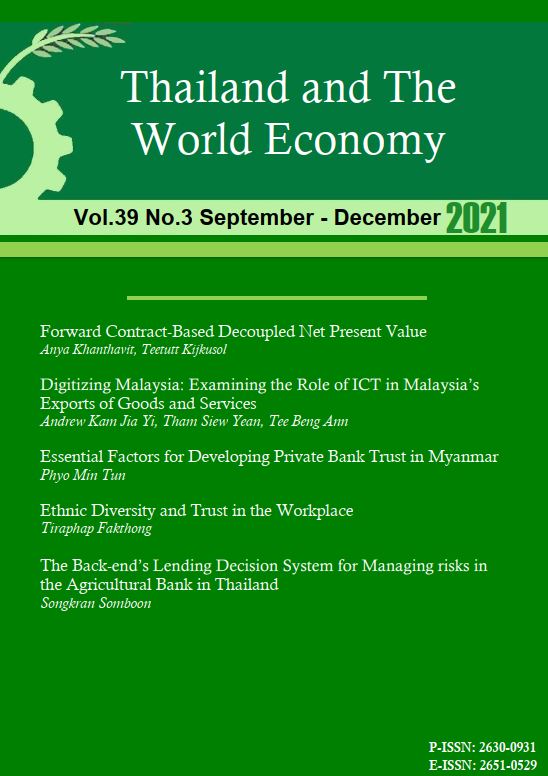The Back-end’s Lending Decision System for Managing risks in the Agricultural Bank in Thailand
Keywords:
Lending decision system, Credit risk, Affordability risk, Agricultural credits, Logit model, Artificial Neural Network model, Model validations, Financial discipline, Agricultural householdsAbstract
The main objective of this study is to develop the back-end’s lending decision system of the Bank for Agriculture and Agricultural Cooperatives, a major lender in Thailand’s agricultural sector. The study highlights the application of the system to help the Bank to manage credit risk and affordability risk in agricultural credits. The Logit model and the Artificial Neural Network (ANN) model have been developed in this study to reflect risk factors/variables of the Thai agricultural sector to identify the probability of default in each obligor. The development of the models and the model validations complied to be consistent with the advanced internal rating-based approach in the Basel capital accord. The study shows how back-end agricultural loan exposure is typical and can be managed on a portfolio basis which will enable the bank to set the credit approval or rejection criteria, diversify the risk in each of the portfolio shares, determine the risk-based pricing in each of borrowers, determine the amount of credit, optimize the portfolio returns, calculate the capital adequacy in the portfolio. The back-end’s lending decision system is also used as an instrument to support the implementation of appropriate credit policies in handling agricultural household’s excess debt, as well as, promoting and supporting financial discipline building for agricultural households in the rural sector of the country.
References
Altman, E. I., Glancario, M., & Varetto, F. (1994). Corporate distress diagnosis: Comparisons using Linear discriminant analysis and neural networks (The Italian experience). Journal of Banking and Finance, 18, 505-529.
Bandyopadhyay, A. (2007). Credit risk models for managing bank’s agricultural loan portfolio. ICFAI Journal of Financial Risk Management, 5(4), 86-102.
Barney, D. K., Graves, O. F., & Johnson, J. D. (1999). The farmers home administration and farm debt failure prediction. Journal of Accounting and Public Policy, 18, 99-139.
Bank of Thailand. (2005). Circulated letter No.: ThorPorTor. SorGorSor. (03) Wor. 227/2548
Re: Guidelines for Risk Management Practices. Retrieved from https://www.bot.or.th/
Thai/FIPCS/Documents/FPG/2548/EngPDF/25480006.pdf
Bank of Thailand. (2012). Notification of the Bank of Thailand No. FPG. 16 / 2555 Re: Regulation on the Calculation of Credit Risk-Weighted Assets for Commercial Banks under Internal Ratings-Based Approach (IRB). Retrieved from https://www.bot.or.th/Thai/FIPCS/Documents/FPG/2555/EngPDF/25550334.pdf
Bank of Thailand. (2019). Policy guidelines for appropriate retail credit to take care of the problem of excessive debt of the household sector. Retrieved from https://www.bot.or.th/
Thai/FinancialInstitutions/Publications/Pages/ConsultationPaper_Loan.aspx
Basel Committee on Banking Supervision. (2005a). Studies on the validation of internal rating system, Working Paper No.14 (Revised version). Retrieved from www.bis.org/publ/bcbs_wp14.pdf
Basel Committee on Banking Supervision. (2005b). An explanatory note on the basel II IRB risk weight Functions. Bank for International Settlement. Retrieved from https://www.bis.org/bcbs/irbriskweight.pdf
Basel Committee on Banking Supervision. (2011). Basel III: A global regulatory framework for more resilient banks and banking systems. Retrieved from https://www.bis.org/publ/bcbs189.pdf
Bennouna, G. & Tkiouat, M. (2019). Scoring in microfinance: Credit risk management tool –case of Morocco-. Procedia Computer Science, 148, 522-531.
Chen, W. -S., & Du, Y. -K. (2009). Using neural networks and data mining techniques for the financial distress prediction model. Expert Systems with Applications, 36(2), 4075-4086.
Coakley, J. R., & Brown, C. E. (2000). Artificial neural networks in accounting and finance: Modeling issues. International Journal of Intelligent Systems in Accounting, Finance & Management, 9, 119-144.
Hu, Y. (2008). Incorporating a non-additive decision making method into multi-layer neural networks and its application to financial distress analysis. Knowledge-Based Systems, 21(5), 383-390.
Kammoun, A., & Triki, I. (2016). Credit scoring models for a Tunisian microfinance institution: Comparison between artificial neural network and logistic regression. Review of Economics & Finance, 6, 61-78.
Lee, T. H., & Jung, S. C. (2000). Forecasting creditworthiness: Logistic vs. artificial neural network. The Journal of Business Forecasting Methods and Systems, 18(4), 28-30.
Limsombunchai, V., Christopher, G., & Minsoo, L. (2005). An analysis of credit scoring for agricultural loans in Thailand. American Journal of Applied Sciences, 2(8), 1198-1205.
Römer, U., & Mußhoff, O. (2017). Can agricultural credit scoring for microfinance institutions be implemented and improved by weather data? DARE Discussion Papers 1703, Georg-August University of Gottingen, Department of Agricultural Economics and Rural Development (DARE).
Somboon, S. (2017). Credit risk management system for managing risk in farmer loan portfolio of the agricultural financial institution in Thailand. NIDA Development Journal, 57, 100-130.
Turvey, C. G. (1991). Credit scoring for agricultural loans: A review with application. Agricultural Finance Review, 51, 43-54.
Turvey, C. G., & Weersink, A. (1997). Credit risk and the demand for agricultural loans. Canadian Journal of Agricultural Economics, 4, 201-217.
Turvey, C. G., & Brown, R. (1990). Credit scoring for a federal lending institution: The case of Canada’s farm credit corporation. Agricultural Finance Review, 50, 47-57.










